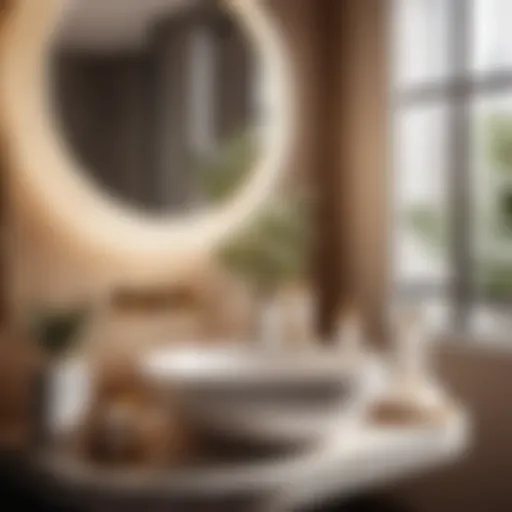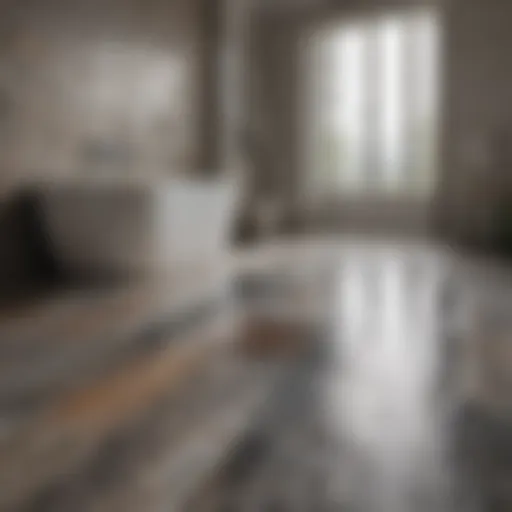Enhancing Your Bedroom: Thoughtful Additions for Comfort


Intro
Transforming your bedroom into a tranquil haven can significantly enhance your well-being. This commitment goes beyond mere aesthetics; it touches upon comfort, functionality, and personal style. Thoughtful additions can elevate the experience within this intimate space.
Designers encourage us to consider both the practical and the experiential facets of a bedroom. What works for one individual may not necessarily resonate with another, thus personalization is key. In this guide, various items including practical furnishings, aesthetically pleasing decor, and advanced technology will be explored. Each selection plays its role in creating an atmosphere conducive to relaxation and rejuvenation.
As we embark on this journey, understanding the elements that will forge your ideal bedroom is essential. Let's proceed systematically, considering every thoughtful addition that might resonate with your needs and maintain functionaility.
Materials:
To kick-start your project, a well-outlined list of materials is vital. Here’s what you need for a basic DIY bedroom enhancement—especially if you’re integrating practical features along with decorative touches. The exact measurements can vary based on your space, but approximations will be provided.
Basic Materials List:
- Wall paint: 1 gallon (for a standard 10x12 room)
- Wood boards (for shelving): (2) 1”x10”x8’, and (1) 1”x10”x6’
- Wall-mounted brackets: 4 units
- Accent cushion covers: 3 units (Approx. 18”x18”)
- Smart light bulb: 1 unit (compatible with your smart home assistant)
- Wall art/prints: 2-3 pieces (size varies)
- Area rug: 5’x7’
These materials balance between utility and decor. Having quality materials ensures long-lasting enhancements to your space.
Required Tools:
- Paintbrushes and rollers
- Level
- Drill and drill bits
- Screwdrivers (flat-head and Phillips)
- Measuring tape
- Pencil (for marking)
- Paint tray
- Safety goggles
By clearly defining the materials and tools at the start of your enhancement project, you position yourself for successful implementation. Consider detailing your project’s flow in advance as you work through the DIY steps.
Detailed Instructions:
Continue learning how to prepare and execute this thoughtfully, ensuring a seamless application of your vision. For first-timers or seasoned improvement aficionados, structure is essential. Building your dream bedroom involves manageable steps, thus making sure you calculate timing and breaking down the entire process could save confusion.
Over to you—process this information and compile your plan while thinking through how these elements integrate.
Empowered decision-making guides transitions in personal spaces.
Each chosen item needs careful consideration and placement. Typically, the physical spaces can seem small when cluttered, conversely, they turn expansive with minimal, thoughtful decorations that harmonize the entirety. The inquiry into functionality and decorative layers molds each result.
In remaining steps, the process will unravel further into a meticulous execution demonstrating key techniques, along with known pitfalls to avoid along the way.
Understanding Your Bedroom Needs
Understanding the specific needs of your bedroom is vital when looking to enhance the space. This section sets the foundation for thoughtful additions, illustrating how any improvements should align with personal preference and environmental constraints. Assessing these needs offers significant benefits that can lead to decisions promoting both functionality and well-being.
Evaluating Space and Layout
Evaluating the current space and layout of your bedroom comes first. Abundant dimensions outdoor disappears in where sleep habitabtion ds well between the walls. Identifying how every portion of the room is utilized can maxmimize its capabilities. Begin by measuring your room thoroughly, taking into accounts:
- Total area: Get a clear number for width and length.
- Existing furniture: Observe sizes of all furniture items.
- Circulation pathways: Understand flow and accessibility.
This step determines if your current layout promotes comfort and ease of movement. With garage peak she suns bright and broadenhge. Confirm feelings as natural, too
Defining Purpose and Functionality
The next step is defining the purpose and functionality of your bedroom. Increasingly changing how the space resolves tradin basises a continuous variable from maybe just a room for sleep.
Begin by defining what activities will ypccar in this space beyond tantrums in perfecto historicating other better options. Will it double as a work area, or have lounge capabilities? Consider the following:
- Implement multi-functional furniture to save spend time immensely too.
- Ensure enough storage to keep essential belonging s manage for transparent economization.
- Adapt the space to accommodate activities such as reading, relaxing simmultanaieously.
In summary, knowing your own needs guides the decision process while ensuring enhancements seamlessly fit within personal hyangesty dymamisms.
Core Furniture Essentials
In any bedroom, the furniture choices set the tone for both functionality and comfort. The elements you select here do not merely serve aesthetic purposes; they lay the foundation for how well your space meets your individual needs. Understanding the importance of core furniture essentials will help you create a balanced environment that caters to relaxation and personal expression.
Upgrading Your Bed Frame
The bed frame is a central feature of your bedroom. A well-chosen frame does more than support your mattress; it acts as a focal point that influences the entire aesthetic of the room. Upgrading your bed frame opens several possibilities.
- Materials: Consider materials such as solid wood, metal, or upholstered frames. Each material can contribute differently to the room's vibe. For instance, a wooden frame gives a rustic feel, whereas metal offers a more industrial look.
- Height and Style: The height of the frame can affect accessibility and ease of getting in and out of bed. Styles vary widely from sleek contemporary lines to ornate designs with intricate details.
- Integration: Ensure that your chosen frame fits well with existing furniture and color palettes in your bedroom. A purposeful selection can elevate the overall coherence of the design, reaching harmony that extends the room's functionality. Think about how this upgrade better aligns with your lifestyle.
Choosing the Right Mattress
Selecting the right mattress is critical for ensuring a good night's sleep. It helps in maintaining proper posture while providing comfort. Different factors play a role in making this selection a successful one.
- Material Selection: Materials such as latex, memory foam, and hybrid options provide various levels of support and comfort. Some maintain heat, while others offer breathability. Consider your personal comfort preferences along with any potential health issues you or your partner may have, such as allergies or back problems.
- Firmness Levels: Firmness varies by brand and design. It creates diversity in selection but complicates comparisons. Generally, side sleepers may prefer softer options, whereas back or stomach sleepers may require firmer support.
Extensive testing, if possible, can lead to a better match that suits your preferences and needs.
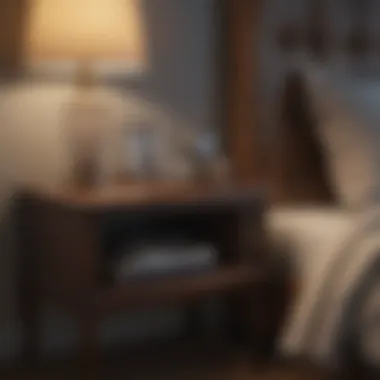

Functional Nightstands
Having functional nightstands is integral to bedroom organization and accessibility. The functions they serve can simplify various nighttime routines.
- Storage Solutions: Opt for nightstands with drawers or compartments. This enables easy storage of items like books, glasses, or medications within reach.
- Style Matching: It’s crucial that nightstands complement the bed frame and other furniture pieces. A cohesive appearance enhances visual appeal without overwhelming the space.
- Surface Utility: Arrange lamps, alarm clocks, or decorative items on top. Ensure there is balanced prevalence of utility and aesthetics.
Optimizing Storage Solutions
Effective storage solutions free your space from clutter, contributing to a calmer atmosphere. Considering how you utilize your bedroom's storage layout is paramount.
- Under-bed Storage: This is often an overlooked area. Utilizing boxes or drawers can provide ample space for seasonal clothing or bedding.
- Wall-Mounted Options: Look into shelves, hooks, or even floating cabinets. Wall-mounted storage keeps essential items accessible while allowing floor space to maintain orderling vibe in your square footage.
- Axis of Flow: Make sure pathways remain clear and storage access is uncomplicated. For ultimate ease homeowner should incluse easy-to-reach areas semanticalyy boosting your daily experiences.
Through careful consideration of these core furniture essentials, you tailor your bedroom more toward your distictive lifestyle and aesthetic outlined from design inspirations yet resonating with neat functionality in your restful reprieve.
Lighting Considerations
Lighting plays a crucial role in defining the ambiance of your bedroom. Thoughtful lighting can highlight design traits, create mood, and enhance usability. Each aspect of lighting contributes to comfort and functionality.
By understanding various lighting techniques, you can tailor your space to foster relaxation or productivity as needed. Choosing the right lighting involves meticulous planning, considering functionality, aesthetic value, and energy efficiency.
Layered Lighting Approaches
Layered lighting focuses on combining various types to achieve overall illumination. This concept typically includes ambient, task, and accent lighting. Ambient lighting serves as the main source, creating uniform light that fills the room. Task lighting, on the other hand, directs focus onto specific areas such as a reading nook or a vanity desk. Accent lighting can showcase art or architectural features by adding highlighted areas that draw the eye.
Implementing these three layers requires careful placement:
- Layer 1: Ambient Lighting - Utilize ceiling fixtures, wall sconces, or chandeliers. Look for soft light designs.
- Layer 2: Task Lighting - Desk lamps, bedside lights, or focused fixtures work best. Choose adjustable options to control light direction.
- Layer 3: Accent Lighting - Employ picture lights, LED strip lights, or wall-mounted fixtures to highlight features.
Strategic placement and varied intensity contribute to a balanced effect, adapting to every situation from downtime to engaging projects.
Incorporating Natural Light
Natural light enhances mood and helps control circadian rhythms. This element improves the overall health of the inhabitants. Consider positions for windows, and reflective materials to maximize brightness during the day. Using sheer curtains allows sunlight to softly filter without sacrificing privacy.
Important factors include:
- Window Placement: Large windows or glass doors welcoming light.
- Orientation: Position bedding away from harsh sunlight glare.
- Reflective Surfaces: Mirrors or light-colored furnishings can amplify light within the space.
Overall, framing your bedroom meticulously for daylight promotes an open, inviting atmosphere that can greatly boost emotional well-being.
Smart Lighting Options
Smart technology revolutionizes how we approach lighting switches. This style can easily meld convenience with energy efficiency, allowing for adjustment via apps or voice commands. Installing smart bulbs or systems relate functionality at your fingertips. Users can program fixtures for specific times, change colors, or set the mood to fit different scenarios such as relaxation.
Advantages of smart lighting include:
- Remote Control: Manage lights from your mobile device.
- Energy Efficiency: Monitor use and increase savings.
- Customizable Settings: Tailor brightness or light color to desired atmospheres.
As smart homes become the standard, these options pave the road toward greater environmental responsibility and comfortable living environments with minimal effort.
"Harnessing suitable lighting strategies fosters a nourishing living space conducive to both rest and rejuvenation."
Choosing the right lighting strategies aligns with both aesthetic preferences and functional needs while deepening personal comfort. This ensures that every aspect contributes positively to a satisfying experience in your bedroom.
Decorative Elements
Decorative elements play a vital role in transforming a bedroom from a simple sleeping area into a space that truly feels like home. The right decor not only enhances aesthetic appeal but also influences the mood and atmosphere of the room. By integrating thoughtful decorative accents, one can achieve a serene living space tailored to personal style.
Art and Personal Displays
Art and personal displays add a unique character to the bedroom. They showcase individual tastes and experiences. Whether it is framed artwork, photographs, or handcrafted items, these displays help create emotional connections in the space. They can serve as conversation starters as well.
Some considerations include:
- Placement: Be strategic in positioning artwork; it should be at eye level for maximum impact.
- Theme: Choose artworks that complement the existing color scheme and overall décor.
- Variety: Mixing different styles of art can lead to interesting contrasts and reactions.
Textile Selections for Comfort
Textiles play an essential role in establishing comfort and providing warmth in a bedroom. They also reflect one’s personal aesthetic preferences. Proper textile selections tie entire bedroom designs together and serve both functional and decorative purposes.
Bedding Options
Bedding options are critical for comfort during sleep and can significantly affect one’s overall rest. Opting for high-quality materials like Egyptian cotton or linen is essential. They are breathable, making the sleep experience more pleasant.
Key characteristics include:
- Softness and Durability: Premium bedding feels luxurious against the skin and lasts longer.
- Temperature Regulation: High-quality materials help with managing sleep temperature.
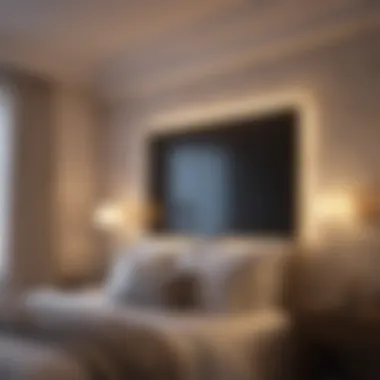

However, bedding requires maintenance. While higher-quality materials may last longer, they might also need special care during cleaning, which some might find cumbersome.
Curtains and Drapes
Curtains and drapes are another important aspect to consider in bedroom decoration. They provide privacy and light control. Moreover, they anchor the room’s color scheme. When choosing curtains or drapes:
- Light-filtering Vs. Blackout: Depending on light requirements, you might prefer sheers for gentle light or blackout varieties for complete darkness during the day.
- Texture and Design: A unique texture can add dimension to the space.
Although curtains and drapes may require periodic cleaning, their ability to alter the mood by filtering light is invaluable.
Area Rugs
Area rugs can greatly contribute to a sleeping space by adding warmth underfoot and creating defined areas within the room. They can also be instrumental in reducing noise and maintaining comfort, especially in bedrooms lacking carpet.
Highlights include:
- Design Continuity: A well-chosen area rug can complement your existing furniture and bedding, enhancing overall coherence in design.
- Non-slip Features: This minimizes the chance of slips, especially in a room that may have multiple surfaces.
However, consider the cleaning process. Some area rugs can be tricky to maintain. Choose options that allow for easy care.
The power of decorative elements should not be underestimated. They are the final touches that transform a mere room into a sanctuary.Each choice, great or small, can significantly impact the ambiance and personal comfort in the bedroom.
Incorporating Technology
In today’s rapidly evolving world, technology plays a crucial role in everyday life, contributing not only to convenience but also to a greater sense of comfort and security at home. The bedroom is no exception. It is where one seeks tranquility and recharge, and incorporating technology can facilitate this process. For a modern bedroom, useful gadgets and apps can make a significant difference in achieving a peacefully managed space. As we explore various technological elements to enhance your bedroom, the benefits, considerations, and implementation of smart devices will be dissected.
Smart Home Integration
Installing smart home devices offers a range of advantages, making day-to-day management of your bedroom easier and more efficient. Devices such as smart speakers, lights, thermostats, and blinds can be controlled remotely or via voice commands.
Here are points to consider about smart home integration:
- Convenience: Simplify your life with automation. You can set routines for lights and appliances, which enhances your comfort without manual effort.
- Energy Efficiency: Smart technology often requires less energy. Thermostats like the Nest Learning Thermostat will adjust automatically, lowering costs and making your home eco-friendlier.
- Security: Integrated security systems provide peace of mind. You can monitor your property with cameras while being alerted instantly to any disturbances.
Integrating smart home technology in your bedroom is not solely about gadgets, it is about creating an ecosystem designed to enhance daily living while providing a feeling of security.
To successfully integrate smart home devices, consider your specific needs and how various gadgets can streamline your daily tasks without overwhelming you. A well-planned setup ensures you feel comfortable and connected.
Sound Systems and Speakers
Enhancing auditory experience is another vital aspect of incorporating technology into your bedroom. Quality sound systems create an immersive atmosphere, whether for music, audiobooks, or white noise machines. Various wireless options are now available. Here are elements to consider:
- Intent and Setup: Determine where you want sound in your bedroom. Do you prefer built-in speakers or a smart sound system like the Sonos One?
- Connectivity: Choose systems that allow connectivity with gadgets such as phones or tablets. Ease of use is important; Bluetooth or Wi-Fi-enabled systems are often preferred.
- Quality: Invest in devices that provide clear sound. The difference in experience can be significant with a quality speaker system compared to standard hearables.
Combining sound technology with smart lighting can produce a layered experience, contributing to various moods and making the space more enjoyable.
Temperature Control Devices
Maintaining comfortable ambient temperatures can often impact sleep quality. This marks temperature control devices as significant for every bedroom. Windows can let in cool air, but integrating devices can further assist. Consider the following:
- Smart Thermostats: As previously mentioned, devices like the Nest assist in managing temperature according to personal preferences and energy mapping, promoting even energy usage.
- Smart Air Conditioners: Machines like the LG ThinQ allow for temperature adjustments from any location through an app, ensuring your room is at the ideal comfort level before entering.
- Heaters and Fans: Simple plug-and-play smart plugs can control heaters or fans remotely, giving users control over temperature manipulation based on preferences for different times of the day.
Through the effective use of these technologies, enhancing comfort in everyday routines becomes an achievable goal. Consider each element carefully, and choose devices that best suit your individual preferences and lifestyle. By doing so, your bedroom will transform into a haven, blending technology with relaxation designed just for you.
Creating a Relaxation Zone
Creating a relaxation zone within your bedroom is fundamental for establishing a serene environment. Life gets busy, and having a designated area to unwind is crucial for both mental and physical well-being. This space should prioritize comfort, tranquility, and personalization. Here, we will explore the essential components such as a reading nook, the inclusion of plants, and elements of aromatherapy.
Reading Nook Essentials
A reading nook can serve as a personal retreat. It can allow you to indulge in your favorite books and escape into different worlds. A successful nook starts with a comfortable chair or even a compact loveseat. Choose furniture pieces that hug the body and offer good back support. Often, people select corner spaces with sweet natural light. This enhances cozy ambience. Along with seating, ensure you have good light for reading. A small lamp with adjustable brightness is ideal. Additionally, incorporate shelving nearby. Store books or additional soft items like throw pillows. This way, not only do you add comfort but also keep your area organized and visually appealing.
Incorporating Plants for Calmness
Plants can actively improve the ambiance of your relaxation zone. They are more than just aesthetic elements; they also play a part in air quality. Choices such as peace lilies and snake plants are particularly great for indoor environments. They require minimal care and look beautiful. A potted plant can make the nook feel energized and inviting. Consider placing them at varying heights or in stylish pots to create visual intrigue. Another point is incorporating greenery stimulates a sense of harmony. Having plants appeals to your senses and can reduce stress.
Aromatherapy and Scent Elements
Scent has a profound impact on mood, and incorporating aromatherapy elements can foster relaxation. Use essential oils known for their calming properties, such as lavender or chamomile. Diffusers are a practical way to disperse fragrances throughout your room. Alternatively, scented candles serve both ambiance and smell; just be cautious when choosing them—opt for natural, non-toxic types. Pillows infused with calming scents can also be of help.
To optimize your relaxation experience, integrate multisensory approaches, appealing to touch, sight, and smell.
Ultimately, a designed relaxation zone acts as a breath of fresh air in a chaotic world. Focus on personalization while ensuring connectivity with style and comfort.
Personalizing Your Space
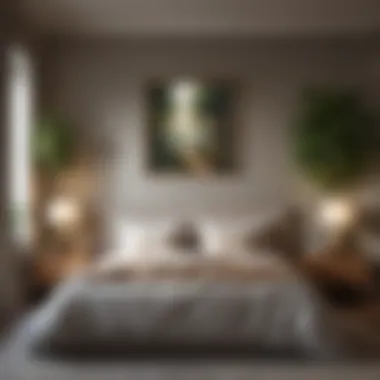

Personalizing your bedroom is critical for crafting a unique sanctuary that embodies your style and meets your needs. It allows for the integration of personal elements reflecting experiences, tastes, and moments. By adding touches of individual style, you can transform a generic space into a room that exudes authenticity and comfort.
Specific elements to consider when personalizing your space include:
- Wall Art: Choose artworks or photographs that evoke fond memories or underline your interests. A well-positioned art piece can serve as a focal point, enhancing the visual narrative of the room.
- Decorative Accessories: Throw pillows, unique lamps, or quirky décor can add personality without overwhelming the space. Select elements that harmonize or set a striking contrast, depending on your vision.
- Textiles and Fabrics: Integrating fabrics that resonate with personal preferences can underscore individuality. Whether it's a patterned duvet cover or soft textiles for a reading chair, ensure they align with both comfort and style.
These personalized additions above contribute not only aesthetic value but also emotional wellness. Each element serves a purpose that resonates with everyday life.
Reflecting Individuality in Design
When aiming to reflect individuality in design, consider what truly resonates with you. Think of your personality, passions, and experiences. Your bedroom should tell your story.
- Prioritize unique elements acquired during travels, workshops, or family heirlooms. Such decor speaks volumes and draws connections.
- Personalization can manifest in functional items as well. Instead of a generic desk, integrate a vintage piece that has special significance.
- Display collections. This could be books, on a dedicated shelf that thrives with your favorites, or even unique items gathered from various locales.
Identifying and highlighting these aspects shall structure an identity-rich bedroom. Design must not only cater to functionality but also include threads of personal significance.
Mood-Enhancing Color Schemes
Color is a powerful element in any space, significantly affecting mood, energy levels, and perceptions. An effective color scheme can elevate a bedroom from a simple resting place into a harmonious retreat.
- Warm Colors: Shades like terracotta, rust, and soft yellows can create an inviting atmosphere, fostering relaxation and comfort.
- Cool Colors: Enhance tranquility with hues such as navy blue, muted green, or soft lavender. These tones offer calmness, helping the mind to unwind should emotional jargon saturate daily routines.
- Neutral Colors: A spectrum of whites, beiges, or grays creates a versatile backdrop featured with vibrant decor items. This flexibility supports alterations over seasons or moods without extensive overhaul.
Utilizing these schemes effectively grants the ability to cultivate mood, enhancing enjoyment and functional usage of the personal space.
Personal spaces should promote tranquility. Each consideration connects to you, creating an intimate interaction between occupants and their environment.
When you emphasize personalized considerations, the result is more than aesthetics. Your instincts drive sustainment of mood amidst shifting contingency routines.
Maximizing Space Efficiency
Maximizing space efficiency is essential in bedroom design, impacting not just aesthetics but also functionality. For homeowners or renters with compact rooms, optimizing available space allows for a more organized environment, while enhancing comfort and practicality. Every square inch should be cherished and utilized effectively to create a soothing retreat.
When you prioritize maximizing space, you promote a harmonious atmosphere where each element serves a purpose. It is not about overcrowding space with furniture; it is about making smart choices. For example, considering multi-functional furniture can save valuable square footage while providing necessary amenities.
Moreover, employing smart organization strategies can help reduce clutter. This impacts mental well-being, as a tidy space encourages a peaceful mind.
Investing in space efficiency leads to not just practicality but inner tranquility, a decorated result rather than debilitating chaos.
Multi-functional Furniture Options
Multi-functional furniture options have become essential for any bedroom that seeks to maximize space. These innovations seamlessly blend various functionalities into single pieces of furniture. For housewives and homeowners, this means less clutter and more efficient use of precious space.
A prime example is a bed with built-in storage drawers. This offers room for blankets, clothes, or other essentials, eliminating the need for additional furniture that may clutter the area. Alternatively, consider a sofa bed, which delivers both comfort and fulfillment for overnight guests without eliminating floor space.
Here are some more useful ideas regarding multi-functional furniture:
- Ottomans with storage: They can serve as seating while housing magazines or blankets.
- Desk that doubles as a nightstand: Provides workspace when needed without taking extra space.
- Shelving units with foldable desk options: They work for storage and promote efficient organization in a modern way.
Using Vertical Space Wisely
Using vertical space wisely is one of the key strategies in small bedroom design. The walls in a room present an often-overlooked opportunity for storage and functionality. Most people primarily think of the floor area, ignoring how much verticality can add to efficiency.
You can install taller bookshelves to avoid taking floor space yet provide extensive storage. Hanging shelves can store décor items or smaller essentials, enhancing organization fluidity. Furthermore, wall-mounted organizers can hold accessories, cleaning tools, or plants, giving each item a fixed position, thus promoting decluttering principles.
Adding hooks and wall brackets can optimize space immensely. For example, placing hangers for magazines or seasonal bags can allow them to be part of the sophisticated design. Similarly, acquiring tall dressers instead of wide ones enhances efficiency, allowing accessibility without sacrificing square footage.
Embracing the vertical elements of a room leads to creativity and innovation that many may not realize are viable options in a bedroom setup.
Sustainability Considerations
Sustainability has become a critical aspect of modern living. It focuses on minimizing environmental impact while enhancing the quality of life. Incorporating sustainability into bedroom design can lead to numerous benefits: lower energy costs, reduced waste, and the creation of a healthier living environment. As homeowners strive to create serene and aesthetically pleasing spaces, they should also consider the long-term impact of their choices on the planet. Addressing sustainability in the bedroom means rethinking materials and practices that are beneficial not just in appearance but also in effect on the ecosystem.
Eco-friendly Materials
Choosing eco-friendly materials is vital in the quest for sustainability. Materials that are sustainably sourced reduce deforestation and pollution. For instance, opting for bamboo or reclaimed wood for furniture not only minimizes impact on natural resources but adds uniqueness to the decor. Similarly, organic cotton or hemp for bedding can positively affect indoor air quality, as they are free from harmful chemicals. Selecting low-VOC paint for walls can also decrease toxins in the home.
Here are some details related to eco-friendly materials:
- Bamboo: Fast-growing and easily replenished, bamboo is excellent for flooring and furniture. It is also very durable, standing the test of time compared to traditional wood products.
- Reclaimed Wood: Using reclaimed wood means repurposing existing structures, thus preventing deforestation.Each piece typically carries a story, adding character to your space.
- Organic Fabrics: Fabrics manufactured without synthetic fertilizers and pesticides are safer for the skin and health. They are available now for various uses such as curtains and cushion covers.
Investing in these materials not only supports sustainability but can enhance the overall beauty and comfort in your bedroom.
Energy-efficient Lighting
The choice of lighting solutions plays a fundamental role in promoting sustainability. Energy-efficient lighting can successfully reduce electricity consumption without sacrificing brightness or ambiance. LED lights are among the best options because they use up to 75% less energy than traditional incandescent bulbs and have a much longer lifespan.
Utilizing energy-efficient lighting is essential for many reasons:
- Reduced Electricity Costs: Installation of LED bulbs can significantly drive down powerful bills, offering savings that add up over time.
- Longevity: Unlike regular bulbs, LED lights have a lifespan that often extends to several decades, reducing the need for frequent replacements.
- Improved Mood: Natural daylight simulations can enhance well-being. By incorporating full-spectrum bulbs, individuals can maintain a positive mood, especially during darker months.
- Smart Lighting Integration: Couple LED systems with smart thermostats and sensors, allowing you to only utilize lighting when needed, further cutting down on waste.
In summation, being conscientious about the materials and the lighting you select for the bedroom aligns your living space with personal style while fostering a commitment to sustainable practices and a healthier environment.
“The greatest threat to our planet is the belief that someone else will save it.” - Robert Swan

